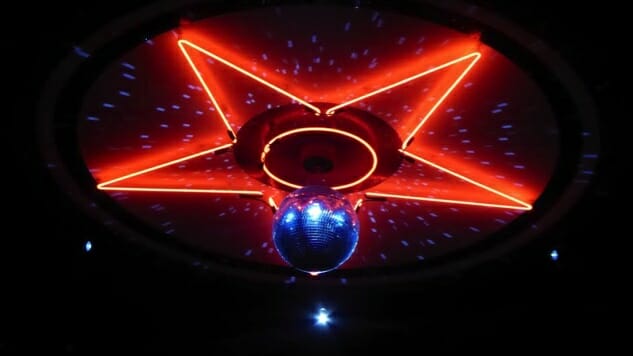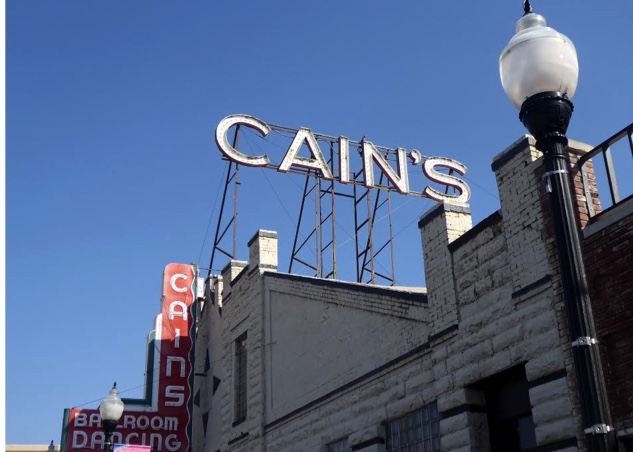
For travelers who love music history, the ultimate destination is Memphis, home of Graceland, Sun Studio, the Stax Museum, Beale Street, the Memphis Rock ’n’ Soul Museum, the Southern Folklore Center, W.C. Handy’s home and Al Green’s Full Gospel Tabernacle Church. Nashville is a contender with the Country Music Hall of Fame, Ryman Auditorium and the Musicians Hall of Fame.
But Tulsa, surprisingly enough, is also a contender, offering the Woody Guthrie Center, the Bob Dylan Archives and Cain’s Ballroom. And in three years the East Oklahoma city will become a real rival with the projected openings of the Bob Dylan Center, the OKPop Museum and Leon Russell’s Church Studio.
This transformation is largely due to one man. George Kaiser, who made billions of dollars in Oklahoma oil and banks, had been a Joan Baez fan at Harvard. He decided that the Woody Guthrie Archives, formerly located in Manhattan and Mount Kisco, New York, belonged in Guthrie’s home state of Oklahoma. When Kaiser ponied up the money for a building and a staff to run it, Guthrie’s children agreed in 2011.

Once the Woody Guthrie Center opened in a downtown empty warehouse in 2013, it was easier for the Kaiser Foundation to convince Bob Dylan that his archives belonged in the same town as those of his role model. For now, Dylan’s thousands of lyrics, photos, audio recordings, video recordings and artifacts are housed at the Gilcrease Museum and only available to legitimate scholars and journalists. But a Bob Dylan Center with displays for the public is slated to open by 2021. Meanwhile Tom Paxton and the Phil Ochs Estate have donated their archives to the Woody Guthrie Center.
It’s one thing to see photos of Guthrie’s acoustic guitar with the words, “This machine kills fascists” scrawled across the soundboard; it’s quite another to stand a few feet away from the fiddle he took with him in the Merchant Marines. Wood-burned into its front are the word, “This machine killed 10 fascists.” Or to stand a few feet from the acoustic guitar that Woody bought for his young son Arlo.
It’s one thing to read the story of how Billy Bragg, Jay Bennett and Jeff Tweedy took the unrecorded lyrics from the Guthrie Archives and added music to the words for the two Mermaid Avenue albums. It’s another to see the actual lyrics those adaptors were working with. The typescript for “Hoodoo Voodoo” is illustrated by colored crayons by Guthrie himself; the lyrics for “Ingrid Bergman” are hung next to the Army Weekly cover photo of the actress that perhaps inspired the song. “California Stars” is signed with the Long Beach address where Guthrie was living when he wrote it.
The original outline, manuscript drafts and illustrations for Guthrie’s loose-with-the-facts autobiography, Bound for Glory, fill another case. In another case are the diagnosis sheets and hospital clothing from the Greystone Park State Hospital, where Guthrie was treated for his debilitating case of Huntington’s Chorea. Appended to the original draft of “This Land Is Your Land” is the hand-scrawled note, “All you can write is what you see.”
In a nearby case is the original, typed version of “Racial Hate at Beach Haven,” a 1952 poem about Guthrie’s Brooklyn apartment building. “My worst enemy,” he writes, “is my landlord that tries his best to make me and my family to live a life of race hate just because he so sickly chose to live his own sad life that way.” A nearby song lyric, “Trump Made a Tramp Out of Me,” reminds us that Guthrie’s landlord was Fred Trump, father of our current president.
In an effort to reach out to non-music fans, the Guthrie Center includes an exhibit on the Dust Bowl, which wreaked so much damage on Oklahoma, Kansas and Texas in the 1930s. The museum has constructed a front porch from houses that survived the storms, and as you sit in a rocking chair on that porch and put on the virtual-reality goggles, you can still see the porch’s posts and overhang.
But instead of a gleaming museum floor in front of you, you see a tilted 1930s jalopy stuck in the shifting sands next to a longhorn’s skull. Then you notice birds, rabbits and tumbleweeds speeding from right to left, and as you turn your head right, a wall of churning dark dirt towers above you as it slowly approaches. Soon it’s upon you.
The next day I visited the Heimereich Center for American Research at the Gilcrease Museum, where Dylan Archives director Mark Davidson had laid out some items on the reading room’s tables. The first thing he picked up in his white gloves was the original handwritten draft of “Chimes of Freedom” on stationary from the Waldorf Astoria Hotel in Toronto.
Between the cigarette burns and coffee ring, the line, “for each unharmful, gentle soul displaced inside a cell” had been crossed out and replaced with, “for each unharmful, gentle soul misplaced inside a jail.” This change yielded a truer rhyme with “trail” and clarified that this person was in jail not by chance but by someone else’s decision. Written in the margin was a line later abandoned: “A voice came sounding like a passenger train.”
In the margins of the draft of “Visions of Johanna,” was a list of rhyming words: “ode, code, toad, showed, gold, load, mode, road.” Dylan used that list to change the line, “We see this empty cage blowing ‘cross the road” to “We see this empty cage now corrode.” On the adjacent table are 20 pages of various drafts for “Jokerman.” If nothing else, these sheets prove that the songwriter wasn’t just spouting lyrics off the top of his head; he was revising and honing until he had just the right word choices.
The British writer Clinton Heylin was sitting at a nearby computer, listening to audio files of live performances for an expansion of his famous Dylan biography. When I sat down at my own computer, I called up a lovely version of “Katskill Serenade” from an unreleased 1992 album produced by David Bromberg. I also found a mono mix of “I’m Not There” that’s much clearer than the stereo mix that was released.
But the highlight of the visit was a large frame drum (a version of the Irish bodhran) with a goatskin head and jingle bells attached inside. It had belonged to Bruce Langhorne, the guitarist who had helped Dylan transition from a solo folk singer to a rock singer with a band in 1963-65. And it was this drum, close enough to touch (though, of course, I didn’t), that had inspired Dylan to write “Mr. Tambourine Man.” These archives, now open only to researchers, will be partially displayed at the soon-to-be-built Bob Dylan Center.
But there’s another reason to visit Tulsa: Cain’s Ballroom is one of the most famous venues in the nation, and it’s still in business. It first opened its doors in 1924, but the building entered American musical history on January 1, 1935, when Bob Wills & the Texas Playboys played there for the first time. This revolutionary band, which combined Texas cowboy music with East Coast swing, played there for seven years, the most fruitful of Wills’ career. The band broadcast live on Tulsa’s KVOO-AM from Cain’s every Saturday at noon and played dances every Thursday and Saturday night.

“After Pappy O’Daniel [a prominent radio sponsor] had chased Bob out of Texas,” OKPop director Jeff Moore explains, “Bob went looking for a place where his working-class audience still had some disposable income in the middle of Depression. Tulsa, where the oil wells were still pumping, had that audience, and soon Bob was often drawing 2,000 people a night.”
It was during the years at Cain’s that Wills transformed Western Swing from a regional sound to a national force in country music. Today the large sepia photos of the performers who joined him in that movement—Moon Mullican, Hank Thompson, Johnny Lee Wills and even the notorious Spade Cooley—still hang from the ceiling at Cain’s.
The ballroom had fallen into sad repair by the end of the century, when brothers Chad and Hunter Rodgers bought the building and restored it to its former glory. They tore out the drop ceiling to open up the rafters to the hangar-style, curved ceiling that Wills had played under. Up in the rafters the new owners hung a new mirror ball inside an orange-neon star (pictured at top). The dark inlay in the wooden dance floor shines under the lights. The brothers have also added a luxurious dressing room for the performers and a new bar/restaurant for the patrons.
Across the North Main Street, OKPop is planning to replace a parking lot with a museum honoring Oklahoma’s contributions to popular music, film and comic art. Across town, Leon Russell’s Church Studio is getting a renovation. In a few years, a Bob Dylan Center will open downtown near the Woody Guthrie Center. And for those interested in more than music, the city boasts an impressive collection of art deco buildings, two worthy small museums and a Double-A baseball team.
But Cain’s remains a key fixture. It was one of just seven venues to host the Sex Pistols on the group’s infamous 1978 American tour. And in the Rodgers’ office is a section of the original dressing-room wall where Sid Vicious tried to punch his way into a view of the women’s bathroom.